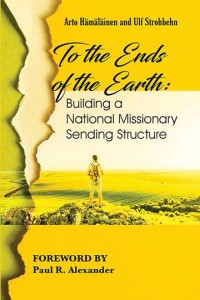To the Ends of the Earth: Building a National Missionary Sending Structure
 Arto Hämäläinen and Ulf Strohbehn, To the Ends of the Earth: Building a National Missionary Sending Structure (Baguio City, Philippines: Asia Pacific Theological Seminary Press, 2020), 126 pages, ISBN 9789718942833.
Arto Hämäläinen and Ulf Strohbehn, To the Ends of the Earth: Building a National Missionary Sending Structure (Baguio City, Philippines: Asia Pacific Theological Seminary Press, 2020), 126 pages, ISBN 9789718942833.
Both of the authors of this book are Pentecostals with extensive experience in international ministry. As the subtitle clearly indicates, this is a book about missions. Specifically, it is about “the organizing of a mission agency” (page xv). In view of this some readers might think that this book is for a specialized audience. In one sense they are right; I understand how someone might come to that conclusion. But, in view of the Great Commission (Matt. 28:18-20) I think missions ought to be of major interest to all believers. It is true that some individuals will be more involved in the day to day “nuts and bolts” operation of the missions structures of churches and denominations; but all Christians should be missions-minded. One point the authors make in the introduction of the book is that all of the churches that the apostle Paul and his coworkers planted did become missions-minded (page 1). The Great Commission is still not complete. If it is going to be completed shouldn’t every church be like the missions-minded churches that Paul and his companions planted?
The book consists of a few pages of endorsements, a foreword, a preface, an introduction, and eight chapters. In the course of the chapters the authors cover a variety of subjects. The following are some of the chapter titles: What is Needed to Start a Missions Program,” “Missions Structure,” and “Key People on the Normal Missions Team.” The authors also address matters related to decision making and finances. The book also helps address issues related to the roles of the local church, the larger missions organization (if there is one), the missionaries, and the church or missions leaders in the receiving country.
Missions ought to be of major interest to all believers.
“How then shall they call on Him in whom they have not believed? And how shall they believe in Him of whom they have not heard? And how shall they hear without a preacher? And how shall they preach unless they are sent? As it is written: ‘How beautiful are the feet of those who preach the gospel of peace, Who brings glad tidings of good things!’” (Romans 10:14-15 NKJV).
As these four structures are adopted and put in place it will not result in a “one size fits all” program for every organization. The authors point out that different groups use different models. In chapter four they mention three, these are: “The Networking Model,” “The Cooperation Model,” and “The Hierarchical Model” (pages 75-78). As they discuss these models they point out both the strengths and weaknesses of each. For example, one of the strengths of the hierarchical model is that responsibilities and decision-making are clearly understood in the organization, one of its weaknesses is that power can be misused(page 78). The authors also tell the reader which parts of the world tend to use which models. They say “Many Asian, African, and Latin America cultures reflect the hierarchal model” (page 78). I find this interesting because these are the areas of the world that have become “the centre of gravity of Christendom” (page 6). Christianity is experiencing dramatic growth on these continents.
The book also outlines who should be on the missions leadership team and what qualities and experience they should have. The members of the team should include: “The Missions Director,” “Missions Board and Committees,” and the “Director of Missions Training” (pages 81-87). The book also looks at the issue of financing various aspects of the missions task (pages 95-98)
Has your church asked what the Lord wants you to do, specifically, in regard to missions?
Reviewed by John Lathrop
Publisher’s page: https://wipfandstock.com/9781725269927/to-the-ends-of-the-earth/
Category: Ministry, Spring 2021


